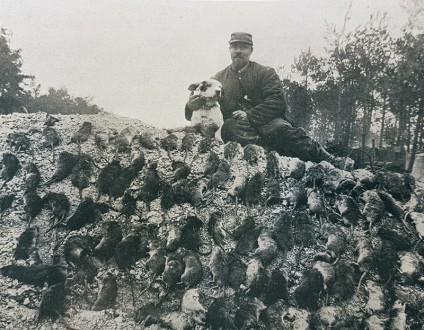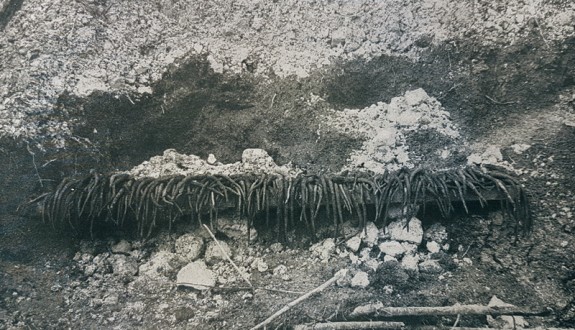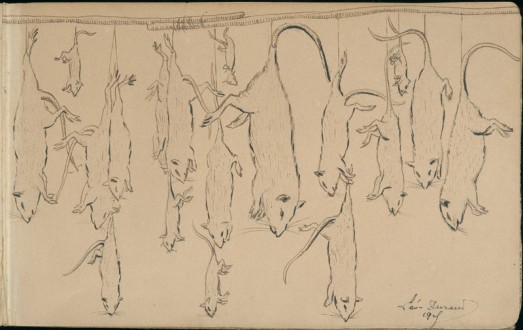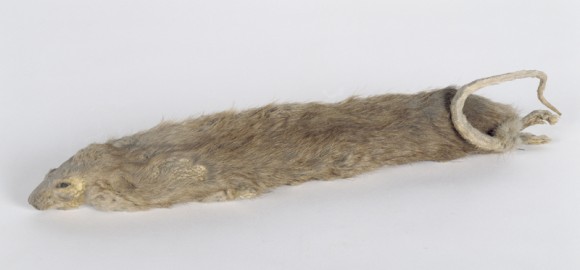December 26, 1915 – French newspaper Le Miroir: “In the destroyed villages and the trenches, the rats, nicknamed by the French “Gaspard”, are everywhere. Many of them grow huge. In order to get rid of them, a Major, an example worthy of emulation by others, had the bright idea to pay his men 5 sous for each batch of 20 killed rats. In order to avoid any cheating, the “hunters” were required to bring the tails of their victims. In a matter of days, some 2000 rodents were exterminated”. On the Western Front, the medical services of the armed forces attempted large-scale poisonings missions against rats. Ratters were introduced, as shown in the photograph above, but nothing seemed to work and the rodents kept on attacking the army warehouses, eating the leathers of the belts and the shoes. © Paris, musée de l’Armée
Robert Goffin wrote “on the animal terror imposed upon the “Poilus” buried deep in the unhealthy, damp trenches, amid dead bodies covered by rodents excited by the stench of rotting corpses. Very quickly, the invasion became unmanageable, there were ten times as many rats in each dugout as men, and each day brought more… Imagine the scene, hundreds of thousands and millions of rats rushing from all directions. Within months, the situation has become so serious that the French have now two enemies, the Germans and the rats, as the latter finds its way to no man’s land, travels from trench to trench, savouring all the digestible products of the two nations… The millions and millions of rats that settle in, housed and fed splendidly, appear to be the true occupants of the trenches … With the fall of night, the Rodents Kingdom comes to life …” © Paris, musée de l’Armée
Rat-hunting in a second-line trench, 1915. Pencil and ink drawing by Léon Durand. © Paris, musée de l’Armée, Dist. RMN-GP / image musée de l’Armée
Le rat
The Charge of the Rats
The earliest account regarding the use of rats and mice in warfare dates back to some 700 years before our era. Herodotus (480 B.C. – 425 B.C.) reported that the Egyptian King Sethon fearing the advance on Egypt by the Assyrian King Sennacherib who had laid siege to Pelusium, released during the night, ten thousand rats and one thousand mice into the valley where the Assyrians were encamped. The rodents ate away the harnesses, the shield straps, the bowstrings and the ropes of the battering rams of the Assyrians who, being put to flight, lifted the siege without a fight.
Rats are feared because they can cause some of the most feared human diseases. The worst of all is the plague. However, in reality this disease is most often transmitted to man by the bite of an infected flea in their furs.
Order your Menu with Rat Dishes
In the West, rat was sometimes served as food during times of war and famine. In 1870-1871, during the siege of Paris, French cook Thomas Genin served rat terrines with a mince composed of donkey meat and fat, at a price of 15 francs. According to him, the rat was a rather insipid fine meat but delicious when well-seasoned. After three months of siege, a rat sold for 3 francs, a cat 10 francs, an egg: 2 francs…
Rats on Espionage Missions
The agility of the rats, their intelligence, their discretion (they communicate by ultrasound) make them formidable adversaries that can easily circulate in an urban area for example. According to the International Union for Conservation of Nature (IUCN), the rat ranks among the hundred most invasive species. In 1975, the Lebanese newspaper Al W’Mahor published an article claiming that, according to various sources in Britain, there was a strong suspicion that the Israelis were sending rats with microchips implants in their brains on espionage missions to major Arab cities in the region.
The Mine Detection Sniffer Rats
In Africa, in particular Mozambique, some species of rats are trained to scent out landmines. Their curiosity, their ability to learn quickly and at low costs, their very light weight and above all their exceptional scent – more powerful than that of a dog – make them the masters of mine detection according to the testimonies of their human colleagues.






Ajouter un commentaire